Stewardship and Governance: Block's Model Analysis Report
VerifiedAdded on 2022/11/30
|7
|1992
|86
Report
AI Summary
This report provides a detailed analysis of Peter Block's stewardship model, exploring its key elements, benefits, and challenges. The report begins with an introduction to the concept of stewardship, defining it within an organizational context. It then delves into Block's model, outlining its core principles, such as shared power, accountability, and service to the community. The report critically evaluates the model, discussing its strengths and weaknesses, and analyzing its potential impact on an organization's culture and performance. Furthermore, it examines the practical application of the stewardship model, considering its suitability for different organizational settings, with a focus on how it can be employed to enhance leadership and governance. The report also provides real-world examples, along with scholarly support from a range of academic sources, offering a comprehensive overview of the model's relevance and implications for modern organizations. The report concludes with a summary of the key findings and insights, emphasizing the importance of stewardship in fostering a more ethical and effective organizational environment.
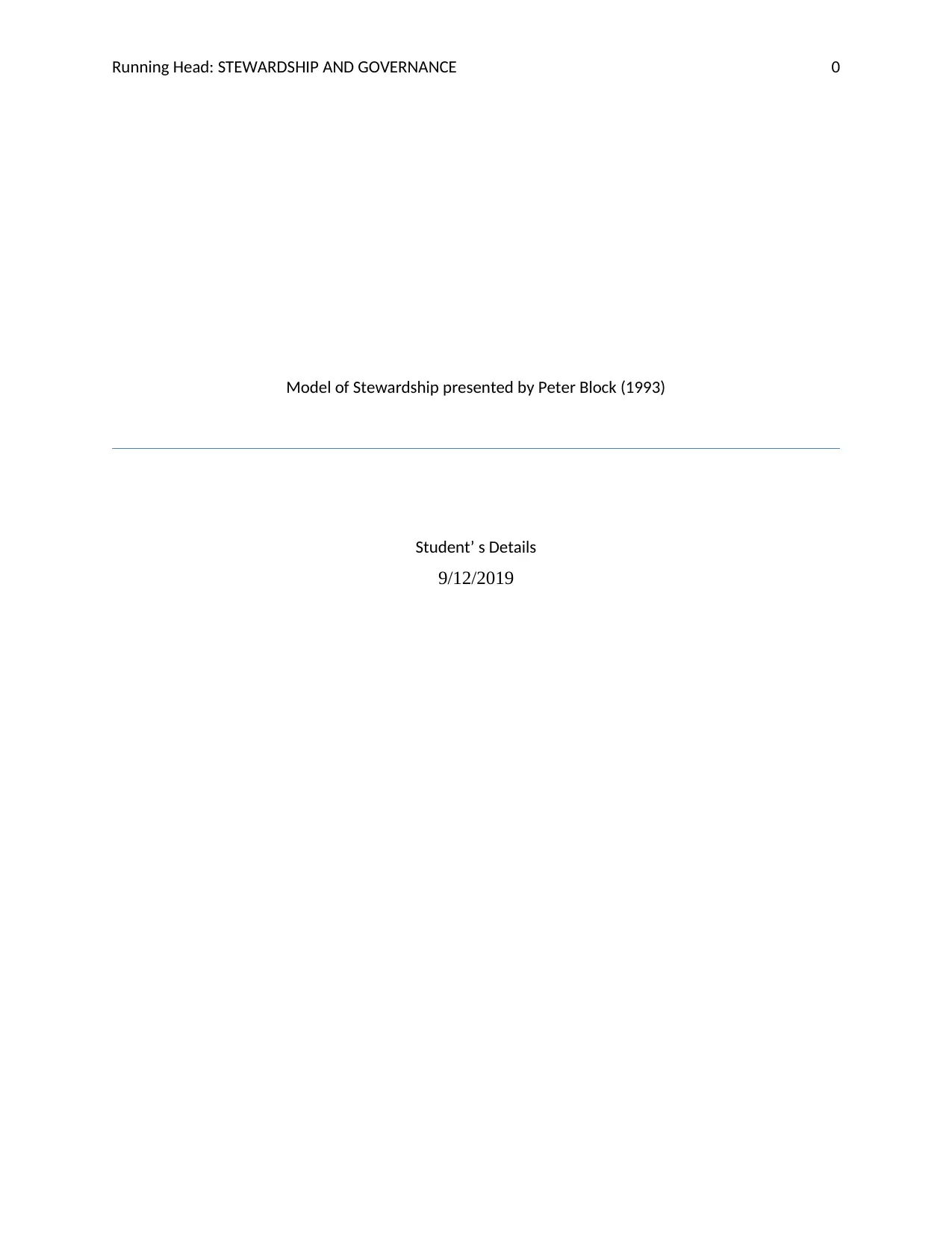
Running Head: STEWARDSHIP AND GOVERNANCE 0
Model of Stewardship presented by Peter Block (1993)
Student’ s Details
9/12/2019
Model of Stewardship presented by Peter Block (1993)
Student’ s Details
9/12/2019
Paraphrase This Document
Need a fresh take? Get an instant paraphrase of this document with our AI Paraphraser
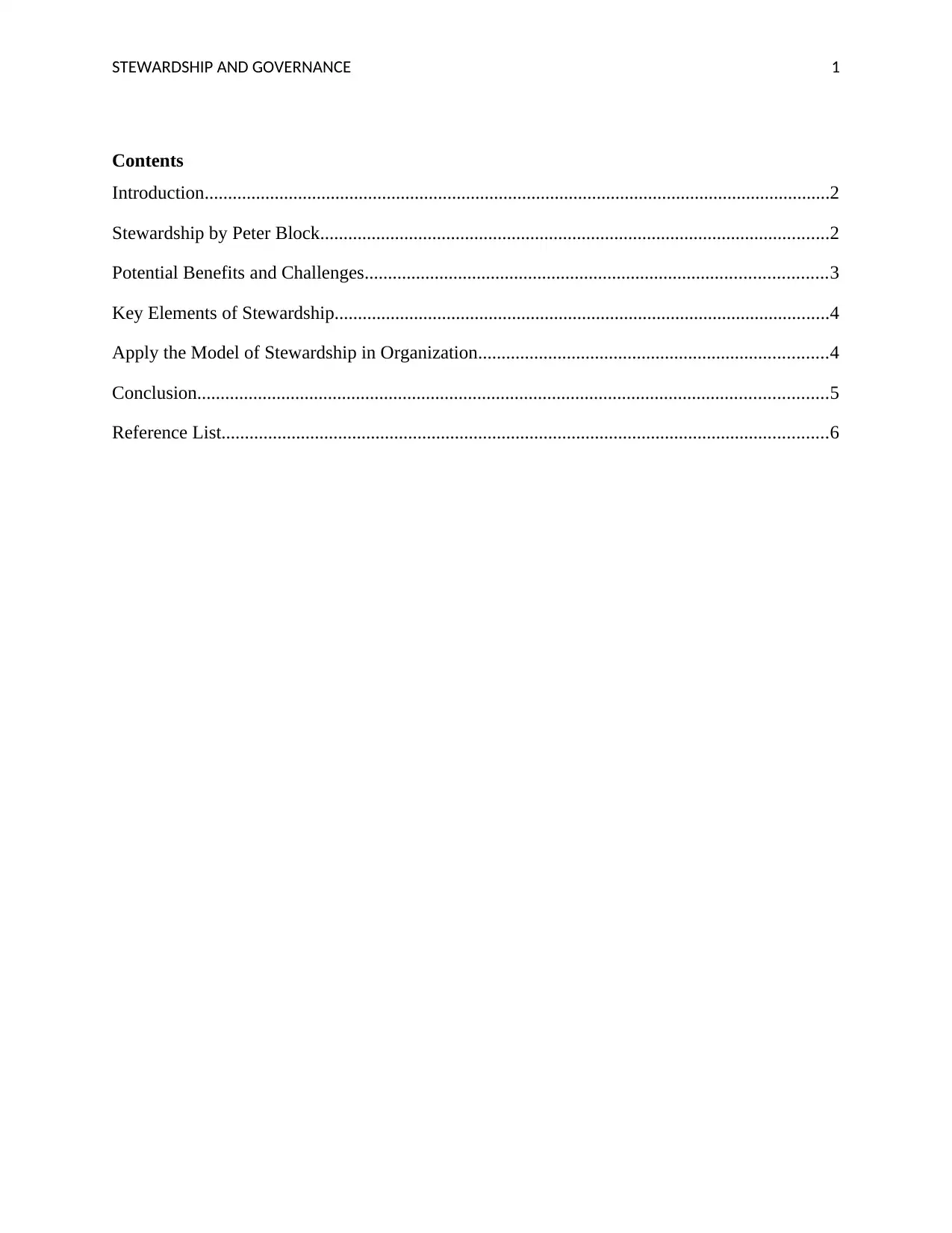
STEWARDSHIP AND GOVERNANCE 1
Contents
Introduction......................................................................................................................................2
Stewardship by Peter Block.............................................................................................................2
Potential Benefits and Challenges...................................................................................................3
Key Elements of Stewardship..........................................................................................................4
Apply the Model of Stewardship in Organization...........................................................................4
Conclusion.......................................................................................................................................5
Reference List..................................................................................................................................6
Contents
Introduction......................................................................................................................................2
Stewardship by Peter Block.............................................................................................................2
Potential Benefits and Challenges...................................................................................................3
Key Elements of Stewardship..........................................................................................................4
Apply the Model of Stewardship in Organization...........................................................................4
Conclusion.......................................................................................................................................5
Reference List..................................................................................................................................6
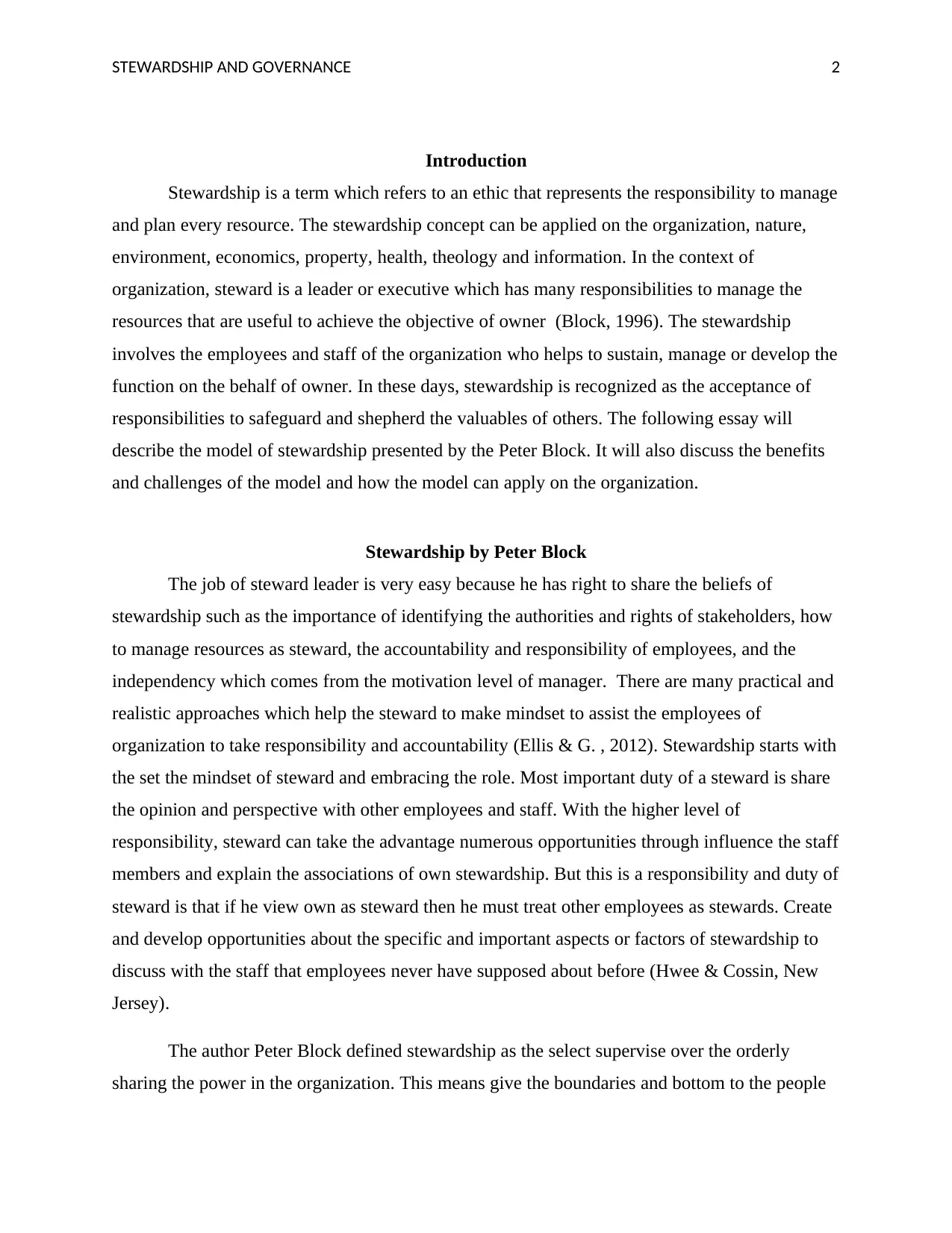
STEWARDSHIP AND GOVERNANCE 2
Introduction
Stewardship is a term which refers to an ethic that represents the responsibility to manage
and plan every resource. The stewardship concept can be applied on the organization, nature,
environment, economics, property, health, theology and information. In the context of
organization, steward is a leader or executive which has many responsibilities to manage the
resources that are useful to achieve the objective of owner (Block, 1996). The stewardship
involves the employees and staff of the organization who helps to sustain, manage or develop the
function on the behalf of owner. In these days, stewardship is recognized as the acceptance of
responsibilities to safeguard and shepherd the valuables of others. The following essay will
describe the model of stewardship presented by the Peter Block. It will also discuss the benefits
and challenges of the model and how the model can apply on the organization.
Stewardship by Peter Block
The job of steward leader is very easy because he has right to share the beliefs of
stewardship such as the importance of identifying the authorities and rights of stakeholders, how
to manage resources as steward, the accountability and responsibility of employees, and the
independency which comes from the motivation level of manager. There are many practical and
realistic approaches which help the steward to make mindset to assist the employees of
organization to take responsibility and accountability (Ellis & G. , 2012). Stewardship starts with
the set the mindset of steward and embracing the role. Most important duty of a steward is share
the opinion and perspective with other employees and staff. With the higher level of
responsibility, steward can take the advantage numerous opportunities through influence the staff
members and explain the associations of own stewardship. But this is a responsibility and duty of
steward is that if he view own as steward then he must treat other employees as stewards. Create
and develop opportunities about the specific and important aspects or factors of stewardship to
discuss with the staff that employees never have supposed about before (Hwee & Cossin, New
Jersey).
The author Peter Block defined stewardship as the select supervise over the orderly
sharing the power in the organization. This means give the boundaries and bottom to the people
Introduction
Stewardship is a term which refers to an ethic that represents the responsibility to manage
and plan every resource. The stewardship concept can be applied on the organization, nature,
environment, economics, property, health, theology and information. In the context of
organization, steward is a leader or executive which has many responsibilities to manage the
resources that are useful to achieve the objective of owner (Block, 1996). The stewardship
involves the employees and staff of the organization who helps to sustain, manage or develop the
function on the behalf of owner. In these days, stewardship is recognized as the acceptance of
responsibilities to safeguard and shepherd the valuables of others. The following essay will
describe the model of stewardship presented by the Peter Block. It will also discuss the benefits
and challenges of the model and how the model can apply on the organization.
Stewardship by Peter Block
The job of steward leader is very easy because he has right to share the beliefs of
stewardship such as the importance of identifying the authorities and rights of stakeholders, how
to manage resources as steward, the accountability and responsibility of employees, and the
independency which comes from the motivation level of manager. There are many practical and
realistic approaches which help the steward to make mindset to assist the employees of
organization to take responsibility and accountability (Ellis & G. , 2012). Stewardship starts with
the set the mindset of steward and embracing the role. Most important duty of a steward is share
the opinion and perspective with other employees and staff. With the higher level of
responsibility, steward can take the advantage numerous opportunities through influence the staff
members and explain the associations of own stewardship. But this is a responsibility and duty of
steward is that if he view own as steward then he must treat other employees as stewards. Create
and develop opportunities about the specific and important aspects or factors of stewardship to
discuss with the staff that employees never have supposed about before (Hwee & Cossin, New
Jersey).
The author Peter Block defined stewardship as the select supervise over the orderly
sharing the power in the organization. This means give the boundaries and bottom to the people
⊘ This is a preview!⊘
Do you want full access?
Subscribe today to unlock all pages.

Trusted by 1+ million students worldwide
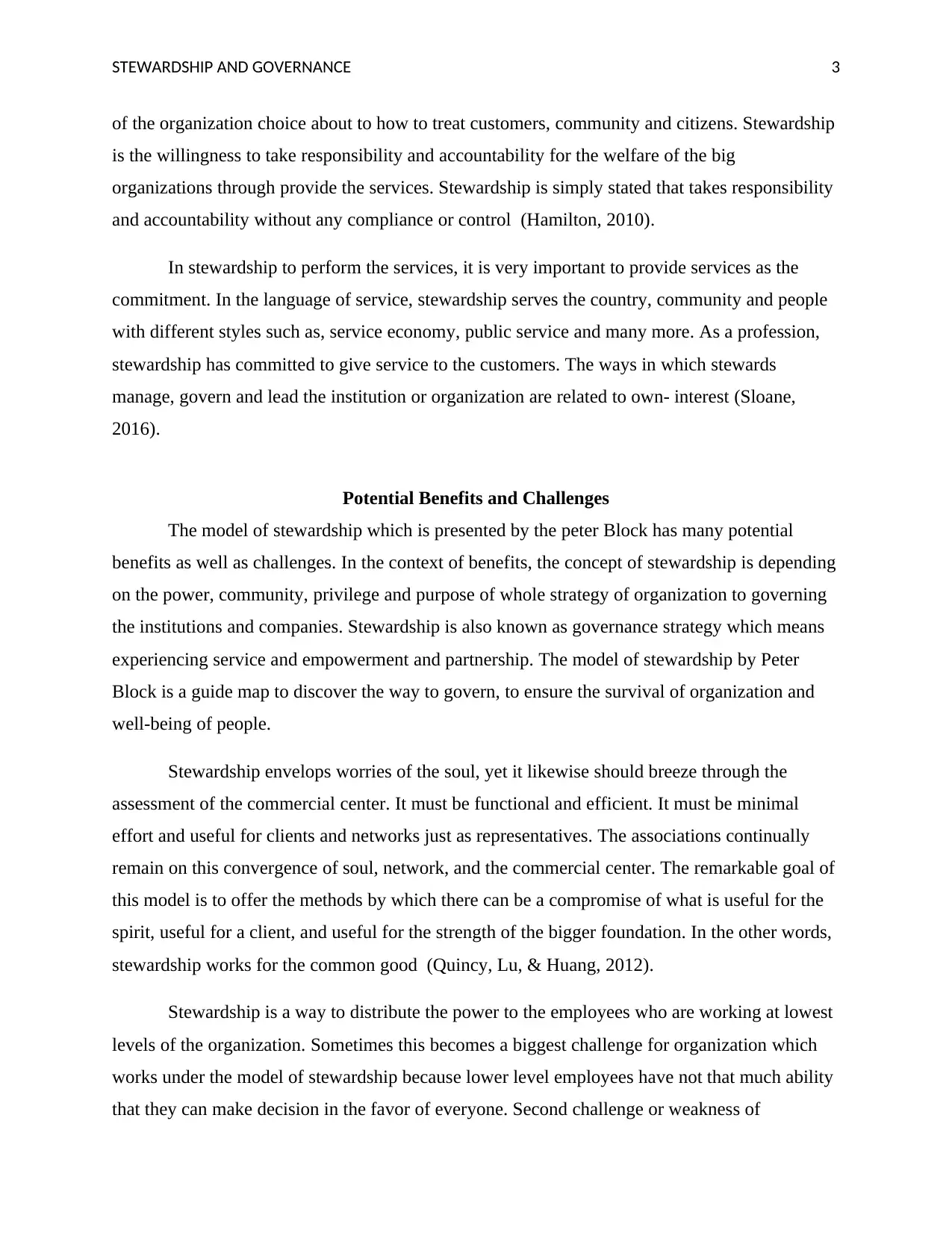
STEWARDSHIP AND GOVERNANCE 3
of the organization choice about to how to treat customers, community and citizens. Stewardship
is the willingness to take responsibility and accountability for the welfare of the big
organizations through provide the services. Stewardship is simply stated that takes responsibility
and accountability without any compliance or control (Hamilton, 2010).
In stewardship to perform the services, it is very important to provide services as the
commitment. In the language of service, stewardship serves the country, community and people
with different styles such as, service economy, public service and many more. As a profession,
stewardship has committed to give service to the customers. The ways in which stewards
manage, govern and lead the institution or organization are related to own- interest (Sloane,
2016).
Potential Benefits and Challenges
The model of stewardship which is presented by the peter Block has many potential
benefits as well as challenges. In the context of benefits, the concept of stewardship is depending
on the power, community, privilege and purpose of whole strategy of organization to governing
the institutions and companies. Stewardship is also known as governance strategy which means
experiencing service and empowerment and partnership. The model of stewardship by Peter
Block is a guide map to discover the way to govern, to ensure the survival of organization and
well-being of people.
Stewardship envelops worries of the soul, yet it likewise should breeze through the
assessment of the commercial center. It must be functional and efficient. It must be minimal
effort and useful for clients and networks just as representatives. The associations continually
remain on this convergence of soul, network, and the commercial center. The remarkable goal of
this model is to offer the methods by which there can be a compromise of what is useful for the
spirit, useful for a client, and useful for the strength of the bigger foundation. In the other words,
stewardship works for the common good (Quincy, Lu, & Huang, 2012).
Stewardship is a way to distribute the power to the employees who are working at lowest
levels of the organization. Sometimes this becomes a biggest challenge for organization which
works under the model of stewardship because lower level employees have not that much ability
that they can make decision in the favor of everyone. Second challenge or weakness of
of the organization choice about to how to treat customers, community and citizens. Stewardship
is the willingness to take responsibility and accountability for the welfare of the big
organizations through provide the services. Stewardship is simply stated that takes responsibility
and accountability without any compliance or control (Hamilton, 2010).
In stewardship to perform the services, it is very important to provide services as the
commitment. In the language of service, stewardship serves the country, community and people
with different styles such as, service economy, public service and many more. As a profession,
stewardship has committed to give service to the customers. The ways in which stewards
manage, govern and lead the institution or organization are related to own- interest (Sloane,
2016).
Potential Benefits and Challenges
The model of stewardship which is presented by the peter Block has many potential
benefits as well as challenges. In the context of benefits, the concept of stewardship is depending
on the power, community, privilege and purpose of whole strategy of organization to governing
the institutions and companies. Stewardship is also known as governance strategy which means
experiencing service and empowerment and partnership. The model of stewardship by Peter
Block is a guide map to discover the way to govern, to ensure the survival of organization and
well-being of people.
Stewardship envelops worries of the soul, yet it likewise should breeze through the
assessment of the commercial center. It must be functional and efficient. It must be minimal
effort and useful for clients and networks just as representatives. The associations continually
remain on this convergence of soul, network, and the commercial center. The remarkable goal of
this model is to offer the methods by which there can be a compromise of what is useful for the
spirit, useful for a client, and useful for the strength of the bigger foundation. In the other words,
stewardship works for the common good (Quincy, Lu, & Huang, 2012).
Stewardship is a way to distribute the power to the employees who are working at lowest
levels of the organization. Sometimes this becomes a biggest challenge for organization which
works under the model of stewardship because lower level employees have not that much ability
that they can make decision in the favor of everyone. Second challenge or weakness of
Paraphrase This Document
Need a fresh take? Get an instant paraphrase of this document with our AI Paraphraser
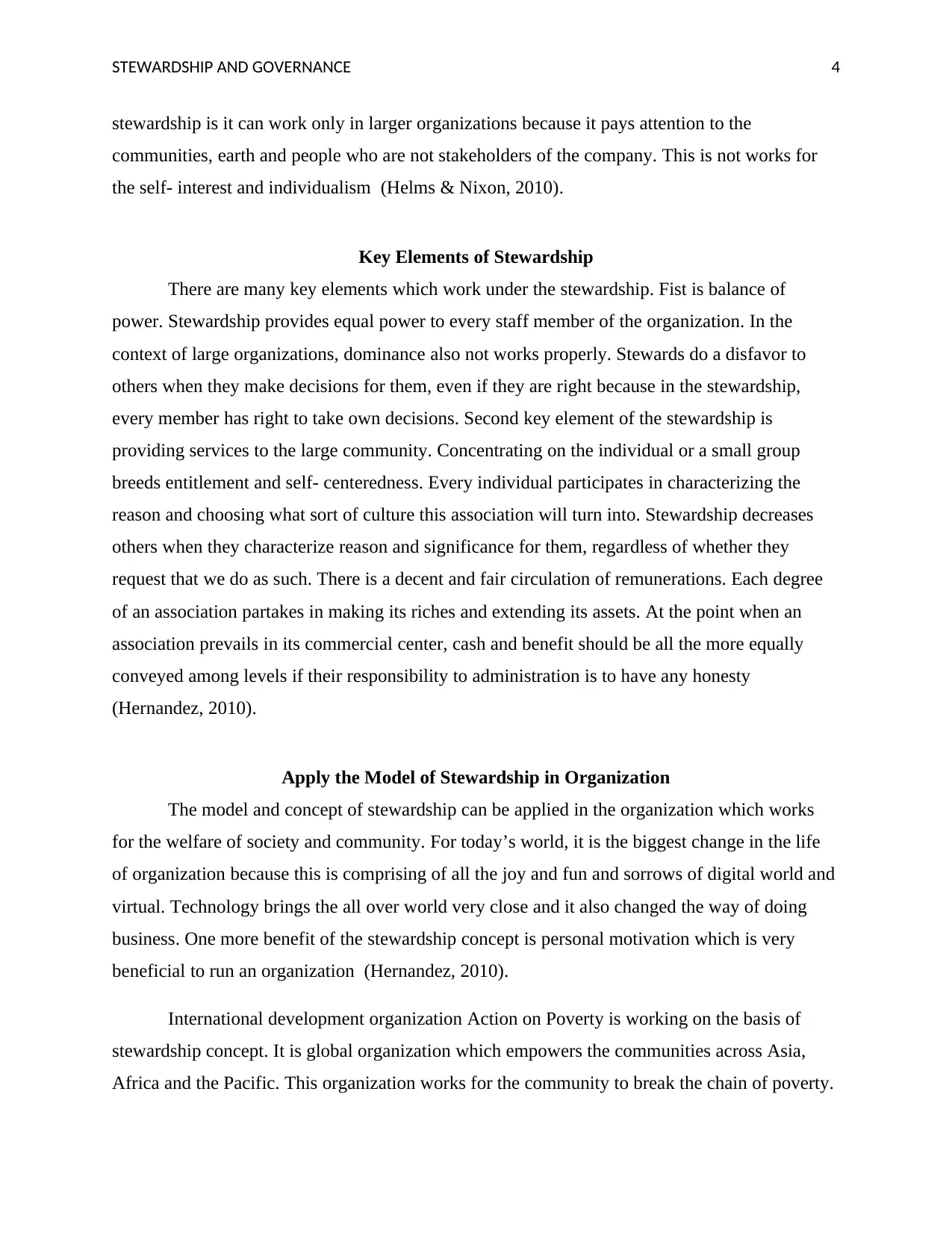
STEWARDSHIP AND GOVERNANCE 4
stewardship is it can work only in larger organizations because it pays attention to the
communities, earth and people who are not stakeholders of the company. This is not works for
the self- interest and individualism (Helms & Nixon, 2010).
Key Elements of Stewardship
There are many key elements which work under the stewardship. Fist is balance of
power. Stewardship provides equal power to every staff member of the organization. In the
context of large organizations, dominance also not works properly. Stewards do a disfavor to
others when they make decisions for them, even if they are right because in the stewardship,
every member has right to take own decisions. Second key element of the stewardship is
providing services to the large community. Concentrating on the individual or a small group
breeds entitlement and self- centeredness. Every individual participates in characterizing the
reason and choosing what sort of culture this association will turn into. Stewardship decreases
others when they characterize reason and significance for them, regardless of whether they
request that we do as such. There is a decent and fair circulation of remunerations. Each degree
of an association partakes in making its riches and extending its assets. At the point when an
association prevails in its commercial center, cash and benefit should be all the more equally
conveyed among levels if their responsibility to administration is to have any honesty
(Hernandez, 2010).
Apply the Model of Stewardship in Organization
The model and concept of stewardship can be applied in the organization which works
for the welfare of society and community. For today’s world, it is the biggest change in the life
of organization because this is comprising of all the joy and fun and sorrows of digital world and
virtual. Technology brings the all over world very close and it also changed the way of doing
business. One more benefit of the stewardship concept is personal motivation which is very
beneficial to run an organization (Hernandez, 2010).
International development organization Action on Poverty is working on the basis of
stewardship concept. It is global organization which empowers the communities across Asia,
Africa and the Pacific. This organization works for the community to break the chain of poverty.
stewardship is it can work only in larger organizations because it pays attention to the
communities, earth and people who are not stakeholders of the company. This is not works for
the self- interest and individualism (Helms & Nixon, 2010).
Key Elements of Stewardship
There are many key elements which work under the stewardship. Fist is balance of
power. Stewardship provides equal power to every staff member of the organization. In the
context of large organizations, dominance also not works properly. Stewards do a disfavor to
others when they make decisions for them, even if they are right because in the stewardship,
every member has right to take own decisions. Second key element of the stewardship is
providing services to the large community. Concentrating on the individual or a small group
breeds entitlement and self- centeredness. Every individual participates in characterizing the
reason and choosing what sort of culture this association will turn into. Stewardship decreases
others when they characterize reason and significance for them, regardless of whether they
request that we do as such. There is a decent and fair circulation of remunerations. Each degree
of an association partakes in making its riches and extending its assets. At the point when an
association prevails in its commercial center, cash and benefit should be all the more equally
conveyed among levels if their responsibility to administration is to have any honesty
(Hernandez, 2010).
Apply the Model of Stewardship in Organization
The model and concept of stewardship can be applied in the organization which works
for the welfare of society and community. For today’s world, it is the biggest change in the life
of organization because this is comprising of all the joy and fun and sorrows of digital world and
virtual. Technology brings the all over world very close and it also changed the way of doing
business. One more benefit of the stewardship concept is personal motivation which is very
beneficial to run an organization (Hernandez, 2010).
International development organization Action on Poverty is working on the basis of
stewardship concept. It is global organization which empowers the communities across Asia,
Africa and the Pacific. This organization works for the community to break the chain of poverty.
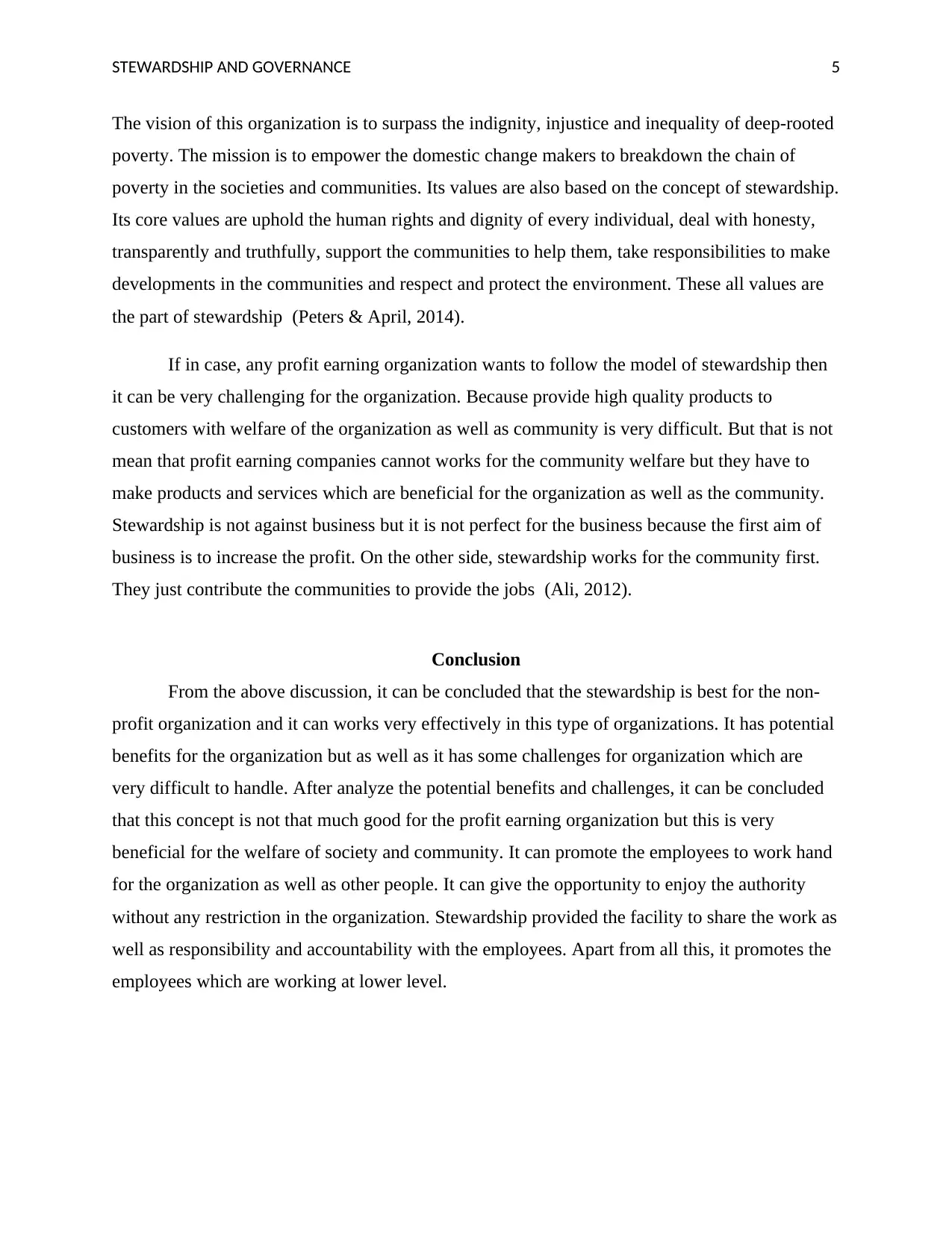
STEWARDSHIP AND GOVERNANCE 5
The vision of this organization is to surpass the indignity, injustice and inequality of deep-rooted
poverty. The mission is to empower the domestic change makers to breakdown the chain of
poverty in the societies and communities. Its values are also based on the concept of stewardship.
Its core values are uphold the human rights and dignity of every individual, deal with honesty,
transparently and truthfully, support the communities to help them, take responsibilities to make
developments in the communities and respect and protect the environment. These all values are
the part of stewardship (Peters & April, 2014).
If in case, any profit earning organization wants to follow the model of stewardship then
it can be very challenging for the organization. Because provide high quality products to
customers with welfare of the organization as well as community is very difficult. But that is not
mean that profit earning companies cannot works for the community welfare but they have to
make products and services which are beneficial for the organization as well as the community.
Stewardship is not against business but it is not perfect for the business because the first aim of
business is to increase the profit. On the other side, stewardship works for the community first.
They just contribute the communities to provide the jobs (Ali, 2012).
Conclusion
From the above discussion, it can be concluded that the stewardship is best for the non-
profit organization and it can works very effectively in this type of organizations. It has potential
benefits for the organization but as well as it has some challenges for organization which are
very difficult to handle. After analyze the potential benefits and challenges, it can be concluded
that this concept is not that much good for the profit earning organization but this is very
beneficial for the welfare of society and community. It can promote the employees to work hand
for the organization as well as other people. It can give the opportunity to enjoy the authority
without any restriction in the organization. Stewardship provided the facility to share the work as
well as responsibility and accountability with the employees. Apart from all this, it promotes the
employees which are working at lower level.
The vision of this organization is to surpass the indignity, injustice and inequality of deep-rooted
poverty. The mission is to empower the domestic change makers to breakdown the chain of
poverty in the societies and communities. Its values are also based on the concept of stewardship.
Its core values are uphold the human rights and dignity of every individual, deal with honesty,
transparently and truthfully, support the communities to help them, take responsibilities to make
developments in the communities and respect and protect the environment. These all values are
the part of stewardship (Peters & April, 2014).
If in case, any profit earning organization wants to follow the model of stewardship then
it can be very challenging for the organization. Because provide high quality products to
customers with welfare of the organization as well as community is very difficult. But that is not
mean that profit earning companies cannot works for the community welfare but they have to
make products and services which are beneficial for the organization as well as the community.
Stewardship is not against business but it is not perfect for the business because the first aim of
business is to increase the profit. On the other side, stewardship works for the community first.
They just contribute the communities to provide the jobs (Ali, 2012).
Conclusion
From the above discussion, it can be concluded that the stewardship is best for the non-
profit organization and it can works very effectively in this type of organizations. It has potential
benefits for the organization but as well as it has some challenges for organization which are
very difficult to handle. After analyze the potential benefits and challenges, it can be concluded
that this concept is not that much good for the profit earning organization but this is very
beneficial for the welfare of society and community. It can promote the employees to work hand
for the organization as well as other people. It can give the opportunity to enjoy the authority
without any restriction in the organization. Stewardship provided the facility to share the work as
well as responsibility and accountability with the employees. Apart from all this, it promotes the
employees which are working at lower level.
⊘ This is a preview!⊘
Do you want full access?
Subscribe today to unlock all pages.

Trusted by 1+ million students worldwide
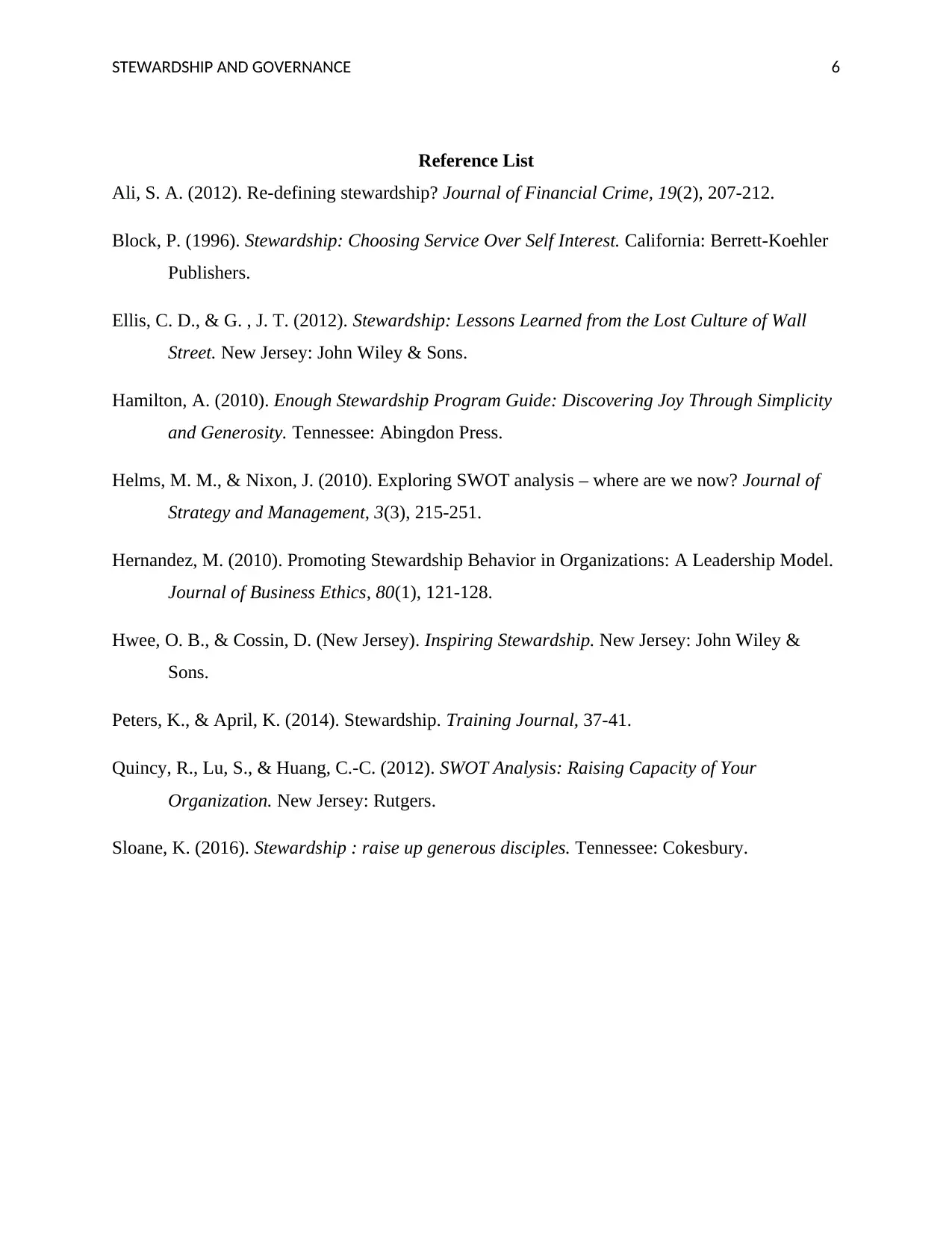
STEWARDSHIP AND GOVERNANCE 6
Reference List
Ali, S. A. (2012). Re-defining stewardship? Journal of Financial Crime, 19(2), 207-212.
Block, P. (1996). Stewardship: Choosing Service Over Self Interest. California: Berrett-Koehler
Publishers.
Ellis, C. D., & G. , J. T. (2012). Stewardship: Lessons Learned from the Lost Culture of Wall
Street. New Jersey: John Wiley & Sons.
Hamilton, A. (2010). Enough Stewardship Program Guide: Discovering Joy Through Simplicity
and Generosity. Tennessee: Abingdon Press.
Helms, M. M., & Nixon, J. (2010). Exploring SWOT analysis – where are we now? Journal of
Strategy and Management, 3(3), 215-251.
Hernandez, M. (2010). Promoting Stewardship Behavior in Organizations: A Leadership Model.
Journal of Business Ethics, 80(1), 121-128.
Hwee, O. B., & Cossin, D. (New Jersey). Inspiring Stewardship. New Jersey: John Wiley &
Sons.
Peters, K., & April, K. (2014). Stewardship. Training Journal, 37-41.
Quincy, R., Lu, S., & Huang, C.-C. (2012). SWOT Analysis: Raising Capacity of Your
Organization. New Jersey: Rutgers.
Sloane, K. (2016). Stewardship : raise up generous disciples. Tennessee: Cokesbury.
Reference List
Ali, S. A. (2012). Re-defining stewardship? Journal of Financial Crime, 19(2), 207-212.
Block, P. (1996). Stewardship: Choosing Service Over Self Interest. California: Berrett-Koehler
Publishers.
Ellis, C. D., & G. , J. T. (2012). Stewardship: Lessons Learned from the Lost Culture of Wall
Street. New Jersey: John Wiley & Sons.
Hamilton, A. (2010). Enough Stewardship Program Guide: Discovering Joy Through Simplicity
and Generosity. Tennessee: Abingdon Press.
Helms, M. M., & Nixon, J. (2010). Exploring SWOT analysis – where are we now? Journal of
Strategy and Management, 3(3), 215-251.
Hernandez, M. (2010). Promoting Stewardship Behavior in Organizations: A Leadership Model.
Journal of Business Ethics, 80(1), 121-128.
Hwee, O. B., & Cossin, D. (New Jersey). Inspiring Stewardship. New Jersey: John Wiley &
Sons.
Peters, K., & April, K. (2014). Stewardship. Training Journal, 37-41.
Quincy, R., Lu, S., & Huang, C.-C. (2012). SWOT Analysis: Raising Capacity of Your
Organization. New Jersey: Rutgers.
Sloane, K. (2016). Stewardship : raise up generous disciples. Tennessee: Cokesbury.
1 out of 7
Related Documents
Your All-in-One AI-Powered Toolkit for Academic Success.
+13062052269
info@desklib.com
Available 24*7 on WhatsApp / Email
![[object Object]](/_next/static/media/star-bottom.7253800d.svg)
Unlock your academic potential
Copyright © 2020–2025 A2Z Services. All Rights Reserved. Developed and managed by ZUCOL.





